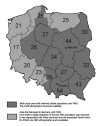Wild vascular plants gathered for consumption in the Polish countryside: a review
- PMID: 17433114
- PMCID: PMC1859986
- DOI: 10.1186/1746-4269-3-17
Wild vascular plants gathered for consumption in the Polish countryside: a review
Abstract
Background: This paper is an ethnobotanical review of wild edible plants gathered for consumption from the end of the 18th century to the present day, within the present borders of Poland.
Methods: 42 ethnographic and botanical sources documenting the culinary use of wild plants were analyzed.
Results: The use of 112 species (3.7% of the flora) has been recorded. Only half of them have been used since the 1960s. Three species: Cirsium rivulare, Euphorbia peplus and Scirpus sylvaticus have never before been reported as edible by ethnobotanical literature. The list of wild edible plants which are still commonly gathered includes only two green vegetables (Rumex acetosa leaves for soups and Oxalis acetosella as children's snack), 15 folk species of fruits and seeds (Crataegus spp., Corylus avellana, Fagus sylvatica, Fragaria vesca, Malus domestica, Prunus spinosa, Pyrus spp., Rosa canina, Rubus idaeus, Rubus sect. Rubus, Sambucus nigra, Vaccinium myrtillus, V. oxycoccos, V. uliginosum, V. vitis-idaea) and four taxa used for seasoning or as preservatives (Armoracia rusticana root and leaves, Carum carvi seeds, Juniperus communis pseudo-fruits and Quercus spp. leaves). The use of other species is either forgotten or very rare. In the past, several species were used for food in times of scarcity, most commonly Chenopodium album, Urtica dioica, U. urens, Elymus repens, Oxalis acetosella and Cirsium spp., but now the use of wild plants is mainly restricted to raw consumption or making juices, jams, wines and other preserves. The history of the gradual disappearance of the original barszcz, Heracleum sphondylium soup, from Polish cuisine has been researched in detail and two, previously unpublished, instances of its use in the 20th century have been found in the Carpathians. An increase in the culinary use of some wild plants due to media publications can be observed.
Conclusion: Poland can be characterized as a country where the traditions of culinary use of wild plants became impoverished very early, compared to some parts of southern Europe. The present use of wild plants, even among the oldest generation, has been almost entirely restricted to fruits.
Figures



Similar articles
-
Changes in the utilization of wild green vegetables in Poland since the 19th century: a comparison of four ethnobotanical surveys.J Ethnopharmacol. 2010 Mar 24;128(2):395-404. doi: 10.1016/j.jep.2010.01.038. Epub 2010 Jan 25. J Ethnopharmacol. 2010. PMID: 20097282
-
Ethnobotanical profiles of wild edible plants recorded from Mongolia by Yunatov during 1940-1951.Hist Philos Life Sci. 2021 Aug 11;43(3):100. doi: 10.1007/s40656-021-00428-0. Hist Philos Life Sci. 2021. PMID: 34382157 Free PMC article. Review.
-
Archival data on wild food plants used in Poland in 1948.J Ethnobiol Ethnomed. 2008 Jan 24;4:4. doi: 10.1186/1746-4269-4-4. J Ethnobiol Ethnomed. 2008. PMID: 18218132 Free PMC article.
-
Traditional Ethnobotanical Knowledge of the Central Lika Region (Continental Croatia)-First Record of Edible Use of Fungus Taphrina pruni.Plants (Basel). 2022 Nov 16;11(22):3133. doi: 10.3390/plants11223133. Plants (Basel). 2022. PMID: 36432861 Free PMC article.
-
Ethnobotanical remarks on Central and Southern Italy.J Ethnobiol Ethnomed. 2007 May 30;3:23. doi: 10.1186/1746-4269-3-23. J Ethnobiol Ethnomed. 2007. PMID: 17537240 Free PMC article. Review.
Cited by
-
Determination of polyphenols and in vitro antimicrobial and antioxidant activity of Calluna vulgaris (L.) Hull.Biol Futur. 2021 Jun;72(2):251-256. doi: 10.1007/s42977-020-00059-9. Epub 2021 Jan 10. Biol Futur. 2021. PMID: 34554478
-
Gathered Wild Food Plants among Diverse Religious Groups in Jhelum District, Punjab, Pakistan.Foods. 2021 Mar 11;10(3):594. doi: 10.3390/foods10030594. Foods. 2021. PMID: 33799901 Free PMC article.
-
Fischer's Lexicon of Slavic beliefs and customs: a previously unknown contribution to the ethnobotany of Ukraine and Poland.J Ethnobiol Ethnomed. 2015 Dec 24;11:85. doi: 10.1186/s13002-015-0073-8. J Ethnobiol Ethnomed. 2015. PMID: 26704421 Free PMC article.
-
One century later: the folk botanical knowledge of the last remaining Albanians of the upper Reka Valley, Mount Korab, Western Macedonia.J Ethnobiol Ethnomed. 2013 Apr 11;9:22. doi: 10.1186/1746-4269-9-22. J Ethnobiol Ethnomed. 2013. PMID: 23578063 Free PMC article.
-
Unity in diversity-food plants and fungi of Sakartvelo (Republic of Georgia), Caucasus.J Ethnobiol Ethnomed. 2021 Dec 31;17(1):72. doi: 10.1186/s13002-021-00490-9. J Ethnobiol Ethnomed. 2021. PMID: 34972527 Free PMC article.
References
-
- Maurizio A. Pożywienie roślinne w rozwoju dziejowym. Warszawa: Kasa Mianowskiego; 1926.
-
- Moerman DE. Native American Ethnobotany. Portland (Oregon): Timber Press; 1998.
-
- Couplan F. Le régal végétal Plantes sauvages comestibles Encyclopédie des plantes comestibles de l'Europe. Vol. 1. Flers: Equilibres; 1989.
-
- Hedrick UP, (Ed) Sturtevant's Edible Plants of the World. New York: Dover Publications; 1919.
-
- Tanaka T. Cyclopaedia of Edible Plants of the World. Tokyo: Keigaku Publishing; 1976.
Publication types
MeSH terms
LinkOut - more resources
Full Text Sources
Miscellaneous

